The Best New York Style Pizza Dough and 14 Tips for Success!!
I’ve been making a lot of this NY style pizza dough recipe …. The obsession started a while back, and I’ve finally found a recipe that I love the best! After years of experiments (and I mean years!), I am now using this recipe based on recommendations from the many fine pizza makers at www.pizzamaking.com and the late great Dough Doctor, Tom Lehmann.

Making Pizza Dough at Home
Making NY style pizza dough is definitely somewhat of an art form. There are so many variables that can be changed aside from the ingredients alone. For example, these variables include:
- oven temperature
- temperature of the water used to make the dough
- proofing methods (room temp vs cold rise)
- order of adding the ingredients (yes, this makes a big difference!)
- mixing time
- use of autolyse
- use of poolish (I don’t do this or the one before, although I have in the past)
And then of course, the toppings which can be simple or as complex as you’d like. But don’t worry too much about all of this – my method is easy and straightforward. Plus, you will make better dough than 99% of the pizza chains out there. You will not want take out anymore!
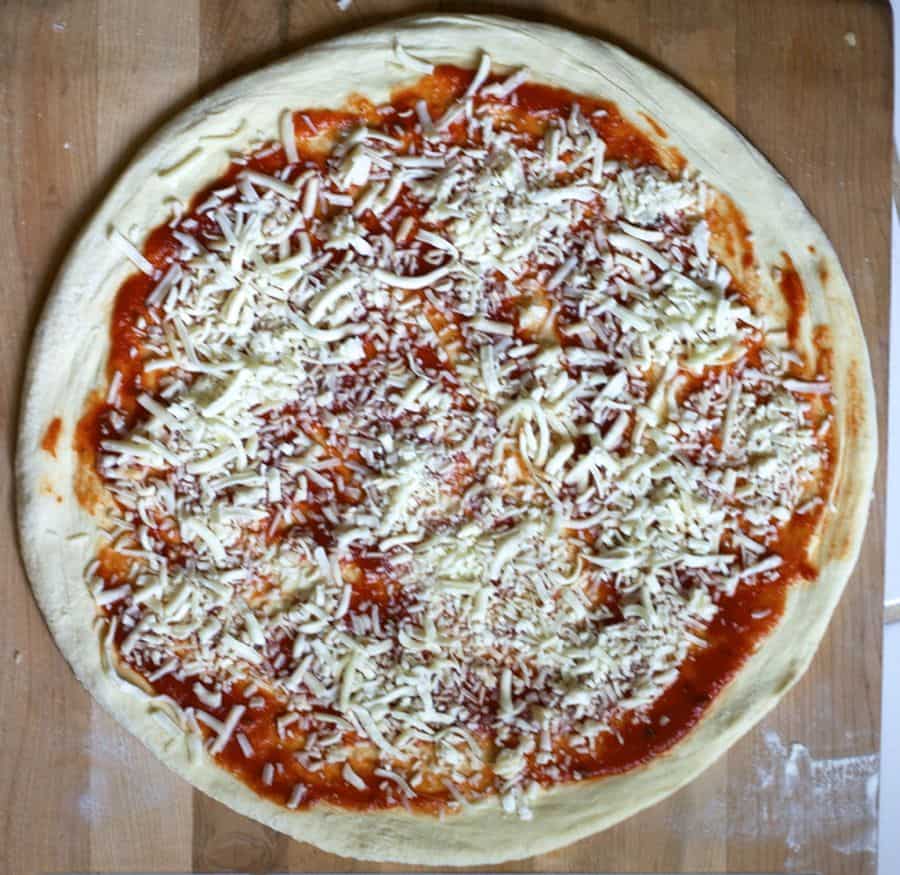
My Favorite Pizza Dough: The Big Secret (How You Proof the Dough)
My all-time favorite dough is NY style dough, which really is classic pizza dough that is stretched out into a thin crust pizza. This type of pizza dough contains water, flour, salt, instant yeast, and olive oil (and sugar especially when baking in a home oven, to help browning).
After it is mixed, it is proofed (left to rise/ferment) in the refrigerator for a minimum of 24 hours and up to 72 hours (it can also be frozen) – this is the big secret. I’ve used the dough up to 5 or 6 days afterwards, so you can essentially prepare dough for the week.
This recipe produces a crisp yet foldable crust that is tender, light, and flavorful and will make enough for four 14-inch pizzas. You can easily double or half the recipe to make 2 or 8 pizzas.

Fourteen Tips for Success
Tip 1: Choosing the flour
Use high-quality flour – I like to use King Arthur’s all purpose or bread flour; higher protein (ie, bread) flours work best. However, I prefer all-purpose flour because I like a lighter, airy crust.
Tip 2: Adding the yeast
Do not add instant dry yeast (IDY) directly to cold or cool water – you may shock the yeast (add the IDY to your flour instead) (please note that IDY differs from active dry yeast, which must be activated by adding it to water).
Tip 3: How much yeast?
Use only enough yeast to “get the job done” – yeast eats the sugar in your flour to produce its leavening effects – I find that if you use too much, your dough will be tasteless (this is just my opinion); however, it is a fact, that too much yeast can make your dough taste bad. Most recipes out there, some of them in well known, published books contain too much yeast!
Tip 4: Cold ferment that pizza dough!
Always use your refrigerator. The best NY style doughs “ferment” or “cure” in the refrigerator for at least 24 hours and up to 48 72 hours. This is called a “cold rise” (vs warm rise on your kitchen counter).
The refrigerator is used to retard (or slow) the dough’s fermentation, allowing that distinctive flavor to come through (ever wonder why some pizza crust tastes different than others, despite the fact that they are both made from just about the same exact ingredients? – this is a big reason why!)
When your dough rises too quickly, the flavor will not develop optimally. Slow rise = MUCH better flavor.
Tip 5: Weigh those ingredients!
Use a scale to weigh the flour instead of using a measuring cup – it is much more accurate and will yield superior results. I’ll admit, I resisted doing this for a loooong time. Just do it. You’ll be glad you did and your dough will be more consistent and much improved.
Tip 6: Add oil last
Mix the oil in as the last step, after the flour has all been incorporated. This is important to allow the flour to hydrate properly.
Tip 7: Flour your dough balls
Before tossing or opening your dough balls, flour them *very* well on each side (if you are a beginner) to ensure they do not stick to your counter or pizza peel. I sometimes use a bit more flour after I begin spreading them.
Tip 8: Keeping those rims a bit puffy
Take care not to “degas” the rim of your pizza as you are spreading your dough! Do NOT ever use a rolling pin! There are many different methods to spread/open your dough ball. I hope to add a few pictures someday of this process.
Tip 9: Baking pizza in a home oven
Ensure that your oven is preheated for a sufficient amount of time (about 1 hour) and bake the pizza within 6 to 8 inches of the top of your oven (ie, your broiler) so that the tops browns sufficiently in conjunction with the bottom of the pizza.
Do not place the stone near the bottom of your oven. I made this mistake for too many years.
After your stone has been preheated sufficiently, the heat from the stone will cook the pizza from the bottom and you can switch the broiler on if you find you need more browning on the top (I now use the broiler to bake my pizzas…more on this sometime in the future).
If you find that your cheese is browning well before your rim attains sufficient color, use partially frozen cheese (ie, place shredded cheese in the freezer while the oven is heating up) and cold sauce or you can drizzle just a bit of olive oil on top of cheese.
Tip 10: Use a pizza stone or steel
Use a pizza stone if you have one. The stone with draw moisture out of the dough and produce a beautifully crisp crust. I use a pizza steel because my stones kept breaking.
Tip 11: Use just the right amount of sauce
Do not use too much pizza sauce – it will make your pizza soggy
Tip 12: Find the right kind of cheese
Do not use low fat cheese to top your pizza or pre-shredded cheese (the former will not melt sufficiently and the latter contains additives that prevent the cheese from sticking together and therefore does not melt very well). The best is low-moisture, whole milk mozzarella.
If you must use pre-shredded cheese, I’ve found that adding the sauce on top of the cheese helps with the melting. Also, do not use too much cheese; apply it sparingly so that you can achieve that mottled NY pizza appearance.
Tip 13: Flour your pizza peel
Use semolina or flour on the bottom of your pizza peel to prevent the pizza dough from sticking but be careful not to overdo it because it will burn.
Tip 14: Learn to launch that pizza
Give the pizza peel a few very small quick jerks to make sure the pizza will easily slide off your pizza peel before attempting to transfer pizza to the oven, and more importantly, rub flour into the peel before placing the dough on top.
Essential Equipment
Please note that as an Amazon affiliate, we earn a small commission if you purchase a product at no additional cost to you.
I adore my baking steel; it’s transformed my home pizzas into restaurant-quality and better. You will love this! A kitchen scale streamlines measurement with remarkable accuracy, while a pizza peel is essential for smoothly sliding pizzas into the oven. And proofing boxes provide an optimal storage for pizza dough fermentation, enhancing flavor, texture, and elasticity.
Please visit our SHOP page for more recommended tools and equipment to make restaurant-style NY-style pizza at home!
How to Stretch the Pizza Dough
A nice video (from The GoodFellas Pizza School of NY), showing how to stretch the dough:

How to Freeze Homemade Pizza Dough
- After mixing dough and dividing into balls, place dough in refrigerator for at least 24 hours.
- Place dough balls on baking sheet lined with plastic wrap or parchment paper, cover loosely with plastic wrap and freeze until firm (~ 2 to 3 hours or up to overnight).
- Wrap frozen dough balls individually in plastic and store in zipper-lock bags for up to 4 weeks.
- When ready to bake, transfer unwrapped dough into the refrigerator for 12 to 24 hours before making pizza.
- Bring dough to room temperature for 20 to 60 minutes before baking (less time for hot kitchen/summer and more time for cool kitchen)
Pizza Dough Calculator
Need more dough? Less dough? Try out our new Pizza Dough Calculator to calculate the weights to get it just right!
Have More Questions?
Please See My NY Pizza FAQ
If you tried this recipe, please leave a 🌟 star rating and let me know how it went in the 📝 comments below! SUBSCRIBE for more recipes.
📖 Recipe

The Best New York Style Pizza Dough
Equipment
- pizza stone or pizza steel for baking
- Standing mixer optional or hand knead
- kitchen scale highly recommended instead of volume measures
Ingredients
Original Recipe for Four 14-Inch Pizzas; want to make more or less? Use the pizza dough calculator
- 6.5 cups (796 g) all purpose flour or bread flour (weighing is most accurate!)
- 2 1/4 cups (493 g) water barely cold water (17.4 oz per 2 1/4 cups)
- 1 teaspoon (3.5 g) instant dry yeast
- 2.5 teaspoons (15.6 g) salt
- 2 teaspoons (7.8 g) sugar
- 1 tablespoon (11.8 g) olive oil
1 Pound of Dough (~454 grams) (use the pizza dough calculator to make more or less dough)
- 2 1/4 cups (274.5 g) all purpose flour or bread flour
- 3/4 cup (170.2 g) water
- 1/2 teaspoon instant dry yeast
- 1 teaspoon salt
- 3/4 teaspoon sugar
- 1 teaspoon olive oil
Instructions
Mixing the Dough
- Place water in mixing bowl.
- In a separate bowl, mix salt and yeast (and sugar if using) into flour
- Combine flour/salt/yeast mixture into water and mix until all the flour has been incorporated.
- After flour has been totally incorporated, add oil and knead for about 4 to 5 minutes (see note)
- Test final dough temperature, which should ideally be between high 70s to low 80s (optional)
Dividing and Rising
- Divide dough into 4 equal pieces (using a digital scale if possible; each ball should weigh 11.5 oz [~326 grams]), shape into a ball, and place in greased, sealed quart-sized container or oiled/greased freezer bag and refrigerate overnight or up to 72 hours (After much experimenting, I have concluded that I like 3 days best but day 2 is good too).
Assembly and Baking
- The following day, remove your dough balls within 1 hour or less of baking and allow the dough to come to room temperature. (the dough will tend to blister more if the dough has not been allowed to come to room temperature however, I often bake coldish dough without problems, just some bubbling)
- In the meantime, place your pizza stone in oven and preheat at 550 degrees (depending on thickness of your stone and your oven’s power) for at least 1 hour
- Open each dough ball using care not to degas, transfer to a pre-floured pizza peel (or on parchment paper), and top with your favorite sauce, cheese, or other toppings.
- Transfer pizza from peel to oven or slide parchment paper onto preheated pizza pan/stone and bake for 4 to 6 minutes each until browned on top and cheese has melted but not burned.
- Enjoy!
Notes
- Use of weight based measurements is highly recommended instead of US Customary. You will need a kitchen scale.
- METRIC amounts DO NOT correspond exactly to the US Customary amounts because, for example, 796 grams equals 6.4 cups (and most can’t measure 0.4 cups or 0.22 cups). Recipe was based on grams.
- Use the Pizza Dough Calculator
- If you want to use the dough the next day, knead a little more (slow speed for about 8 to 10 minutes)
- If you have time to let the dough rest for 3 days, knead for 4 to 5 minutes, low speed or hand knead.
- After mixing dough and dividing into balls, place dough in refrigerator for at least 24 hours.
- Then, place on baking sheet lined with plastic wrap or parchment paper, cover loosely with plastic wrap and freeze until firm (~ 2 to 3 hours or up to overnight).
- Wrap frozen dough balls individually in plastic and store in zipper-lock bags to store for up to 4 weeks (longer may work, but results might vary).
- Before using, transfer unwrapped dough into the refrigerator for 12 to 24 hours before making pizza.
- Bring dough to room temperature for 20 to 60 minutes before baking (less time for hot kitchen/summer and more time for cool kitchen).
- calculate your own using baker’s percentages: 62% hydration, 0.4% yeast, 2% salt, 1.5% oil, and 1% sugar or use my new pizza dough calculator.
Nutrition
Try these other pizzas and this NY pizza sauce:
Buffalo style (one of my absolute favorites)
White with prosciutto
White with spinach and feta
Pizza sauce

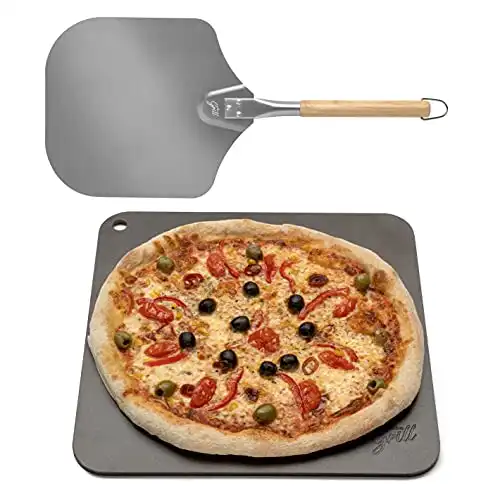
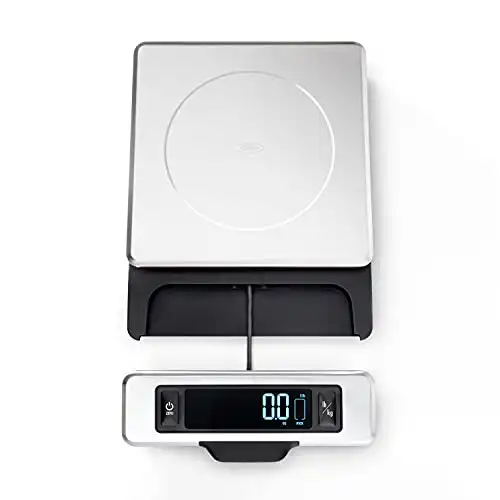
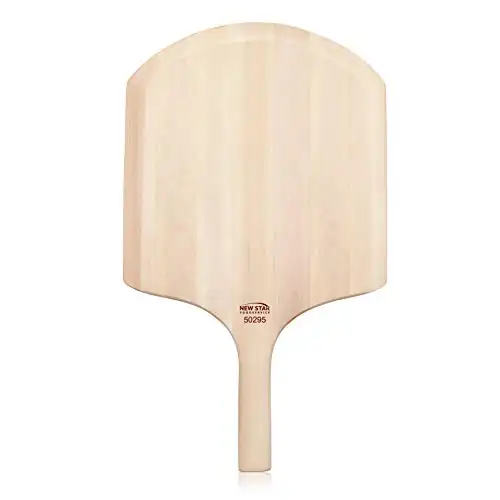
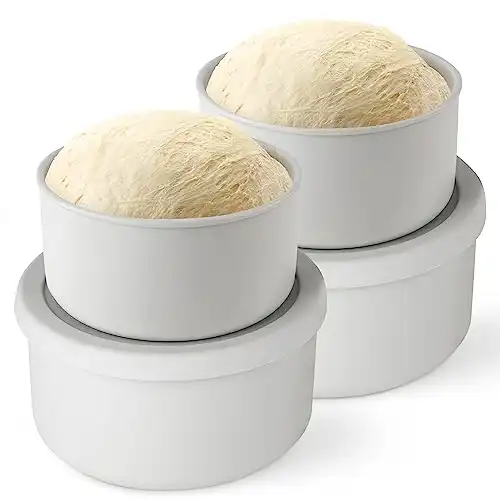
I don’t have a stand mixer……should I just hand knead for 4-5 minutes or use a food processor?
Thanks
You can do either….45 seconds only In the food processor (significantly more time will shred gluten too much) or knead by hand. I like to knead for a few minutes then let rest for a few minutes, knead, rest and so on until you get some gluten development. You’ll know you have gluten development because you will be able to pull on the dough and it won’t break off
Thanks…….kneading it is then…….
Take Care
Could a bread machine be used for the kneading? Thanks.
I’m not sure I’ve never used a bread machine…sorry.
amazing pizza. I was intimidated as someone who’s never made a pizza dough before but this turned out delicious! Thanks Marie!
This is legit. Real NY Pizza dough recipe, sooo delicious!!! I made the first batch a few weeks ago, with two pizzas, then froze the other two dough balls as suggested. Just made the other two pizzas a couple of nights ago and they were just as delicious as the first batch!!! I’m so in love with this pizza dough!!! Thank you for sharing this! I don’t need disappointing take-out from CO pizza places ever again. =D
Hello
I have let the dough balls rise in the fridge for about 15 hours now and they don’t look like they’ve risen at all… Is this normal? Should I do anything about this or just wait?
Thank you
It doesn’t rise much but I’d wait until at least 24 hours
Thank you
Just made a version of this dough. Omg. Been a home pizza maker for 20 odd yrs. and tonight was the night. I only used 2c of KA bread flour and appropriate other proportions (almost 1c of water), but I think the key factor was only a tsp. of yeast. I only wanted to make one pie on the night of. Put in fridge for 2hrs then pulled out when I preheated the oven/stone. Followed the other hints on shaping and not playing to much and voilla, best I’ve ever made. Soft but chewy crust. PepAnchovi!!
Can active dry yeast be used in the recipe? Or does it have to be IDY?
Let the dough sit out at room temp after it has been refrigerated and then shape it into a pizza- there is a video in the post that shows how to shape ..hope that helps?
yes I use them interchangeably with no problems
Do you activate your active dry yeast first if you’re substituting? Thanks!
I never did but the brand I used didn’t require it -so go according to your brand directions
Very excited to try this now with extra time home on our hands- LOVE NY style pizza
Couple questions:
-Please explain “
being careful not to “degas” your dough?
-And when storing during fermenting- do you close and let all air out of the zip lock bags at first and as it fermented revisit them and let air out?
– Also, I’ve been told water matters- as in water in NY is different than NC – one authentic NY family owned pizza place here swears by shipping in water from NY – possibly because of the higher chlorination in NC water. Any direction /thoughts on this? Maybe use bottled?
Thanks
How much does it expand in there?
I think you’ll love it! So the degassing the dough simply means you’re knocking the air out of it. Just handle the dough gently but don’t go crazy it’s fine. And yes, I try to ensure air is out of the bag but I also sometimes use plastic containers so that’s difficult to do. Be sure to spray the inside of the bag or container to lessen the effect of sticking. And frankly, I don’t subscribe to the theory about the New York city water. There are contests yearly about who makes the best New York pie and many people in Texas and on the West Coast are now winning these competitions. Don’t worry about the water you’ll be just fine. It doesn’t expand a whole lot sometimes maybe 20 to 30% depending on the temperature in your refrigerator.
Hi, hope all is well! Just made this recipe and it is currently proofing in the fridge in a large ziplock bag. Question 1: I used some olive oil to oil the bag instead of spray. Was that ok to do? Question 2: it isn’t really in a round shape. It looks more like a cylinder right now in the fridge. When I take it out of the fridge should I first shape it back into a round shape or take it out of the bag, flour both sides, let it rest out of bag to get room temp and then shape into a round shape before starting the molding process? Thank you!!!
All is well hope you are too! Answer 1: yup that’s fine – I sometimes do that too. Answer 2: I’d probably reshape to round and then let rest and then flour etc
Thanks so much for replying! So once I’m ready to use I should take it out of the bag, reshape it round and let it rest on the counter for max an hour? While it rests should it sit on the counter with a little bit of flour on it to avoid sticking? And then once I’m ready to form, flour both sides and begin to mold?
I want to try your pizza dough but you never mention when you shape the dough, only don’t degas it. Your post said never to use a rolling pin but I don’t think a ball of dough is going to make a very good pizza. P,ease clarify.
Put my dough in freezer zipper bags and they didn’t stay in the ball I rolled them up in, is that normal?
Yes it does flatten a bit and the dough will confirm to the shape of the bag/container – normal.
I am from N.Y.City, Manhattan to be exact. I moved to Tennessee , where all the pizza is achain. My husband wanted me to make a fresh pizza. I came across your recipe. Used King Arthur Bread flour. It was the bomb. OMG tasted just like the pizza I got in N.Y. Thank you for sharing this recipe.
I have been in the pizza business most of my life. I like trying new recipes, and this one I am planning on using for my personal wood fired pizza. I have set my recipe a side for now and been using this one with a couple of modifications first substitute salt with garlic powder (not garlic salt) , 2 add 1 tsp Italian season, 3rd 1 tsp of Roman cheese. Hopefully, you will enjoy.
Hi William, so no salt at all? I’ve never tried any pizza dough or bread without salt…what does eliminating salt do for the dough? I can see how the cheese would add the flavor in place of salt but I thought salt needed for strengthening dough too?
I have a wood fire pizza oven and have cookEd Napoletana style pizza but wanted something more with a crispy crust. My question is what time in the pizza oven should I shoot for?
That would all depend on the temp of the oven. Traditional NY style pizza isn’t baked at nearly as high temps as Neopolitan pizza. Using hime oven with a baking steel or stone, I’d shoot for a 5 or 6 minute bake at 500 degrees (12 or 14 inch pizza).
Ok, sorry it autocorrected temp to time. Yeah I would cook the Neopolitan at 750deg + but wasn’t sure for this style in the wood fired oven.
Thanks for your time!
What temp**
I really enjoy this recipe. Would replacing the water with beer work to achieve a “beer crust”?
I have no idea. I’ve never tried it but maybe a fun experiment?
Marie good morning definitely will try to make that recipe, thanks for that.
Could you please help get the dough calculator seems very helpful, unfortunately the link doesn’t work for some reason.
Once again thanks
It could be if you’re using a cell phone…I don’t think it will work unless you use a desktop. Frustrating I know since phone is so convenient. Try from a desktop and print for keeping in your kitchen 🙂
Hey!! I’m so excited to make this recipe. But I accidentally bought fresh mozzarella. It’s a ball with some liquid inside. I was going to grate this and use it for my pizza but I looked online and it says it might make the crust soggy because of high moisture.
Any suggestions or should I try and use the cheese in something else and go find the right stuff?
Thank you!!!
Personally, I would use the fresh mozzarella to make a capresi salad or maybe use it for baked ziti or lasagna to use it up. I’d probably use low moisture preferably for the pasta dishes but the fresh won’t hurt. I use fresh mozzarella to make Neapolitan pizza which is baked at super high temps (800 f plus) and so the Electra moisture is welcome. For NY style, use whole milk, low moisture (Polly-O and Trader Joe’s are consumer brands that have received high grades for their meltability)
If you have fresh mozzarella you can make margarita pizza. Put sauce on dough and bake for a few minutes. Then, top pizza with thin slices of fresh mozzarella and salt and pepper. When pizza is cooked, remove from oven and finish wi5h fresh basil chiffonade. That’s a margarita pizza!
I am excited to try this today! The dough has been in my refrigerator since a Friday morning! Is the dough supposed to rise and get big in the refrigerator?
It grows- but typically not a lot maybe 30% or so